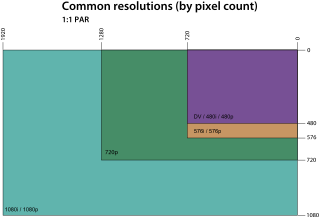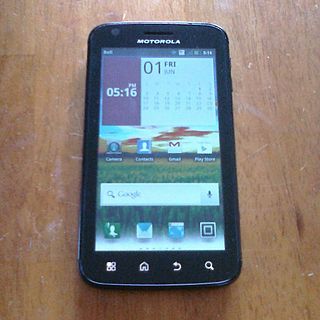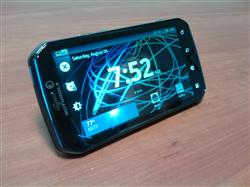Related Research Articles

A smartphone is a mobile device that combines the functionality of a traditional mobile phone with advanced computing capabilities. It typically has a touchscreen interface, allowing users to access a wide range of applications and services, such as web browsing, email, and social media, as well as multimedia playback and streaming. Smartphones have built-in cameras, GPS navigation, and support for various communication methods, including voice calls, text messaging, and internet-based messaging apps.

A laptop computer or notebook computer, also known as a laptop or notebook, is a small, portable personal computer (PC). Laptops typically have a clamshell form factor with a flat panel screen on the inside of the upper lid and an alphanumeric keyboard and pointing device on the inside of the lower lid, although 2-in-1 PCs with a detachable keyboard are often marketed as laptops or as having a "laptop mode". Most of the computer's internal hardware is fitted inside the lower lid enclosure under the keyboard, although many laptops have a built-in webcam at the top of the screen and some modern ones even feature a touch-screen display. In most cases, unlike tablet computers which run on mobile operating systems, laptops tend to run on desktop operating systems, which were originally developed for desktop computers.

A mobile processor is a microprocessor designed for mobile devices such as laptops, and cell phones.

Mobile computing is human–computer interaction in which a computer is expected to be transported during normal usage and allow for transmission of data, which can include voice and video transmissions. Mobile computing involves mobile communication, mobile hardware, and mobile software. Communication issues include ad hoc networks and infrastructure networks as well as communication properties, protocols, data formats, and concrete technologies. Hardware includes mobile devices or device components. Mobile software deals with the characteristics and requirements of mobile applications.

A mobile device, also referred to as a digital assistant, is a computer small enough to hold and operate in the hand. Mobile devices typically have a flat LCD or OLED screen, a touchscreen interface, and digital or physical buttons. They may also have a physical keyboard. Many mobile devices can connect to the Internet and connect with other devices, such as car entertainment systems or headsets, via Wi-Fi, Bluetooth, cellular networks, or near-field communication. Integrated cameras, the ability to place and receive voice and video telephone calls, video games, and Global Positioning System (GPS) capabilities are common. Power is typically provided by a lithium-ion battery. Mobile devices may run mobile operating systems that allow third-party applications to be installed and run.

A clamshell design is a kind of form factor for electronic devices in the shape of a clamshell. Mobile phones, handheld game consoles, and especially laptops, are often designed like clamshells. Clamshell devices are usually made of two sections connected by a hinge, each section containing either a flat panel display or an alphanumeric keyboard/keypad, which can fold into contact together like a bivalve shell.

A tablet computer, commonly shortened to tablet, is a mobile device, typically with a mobile operating system and touchscreen display processing circuitry, and a rechargeable battery in a single, thin and flat package. Tablets, being computers, have similar capabilities, but lack some input/output (I/O) abilities that others have. Modern tablets largely resemble modern smartphones, the only differences being that tablets are relatively larger than smartphones, with screens 7 inches (18 cm) or larger, measured diagonally, and may not support access to a cellular network. Unlike laptops, tablets usually run mobile operating systems, alongside smartphones.

The mobile web comprises mobile browser-based World Wide Web services accessed from handheld mobile devices, such as smartphones or feature phones, through a mobile or other wireless network.

Asus Eee is a family of products by AsusTek Computer Inc. The product family began with the release of the Eee PC subnotebook in 2007; since then, the product family has diversified into a number of PC form factors. According to the company, the name Eee derives from "the three Es," an abbreviation of its advertising slogan for the device: "Easy to learn, Easy to work, Easy to play".
A mobile operating system is an operating system used for smartphones, tablets, smartwatches, smartglasses, or other non-laptop personal mobile computing devices. While computers such as typical/mobile laptops are "mobile", the operating systems used on them are generally not considered mobile, as they were originally designed for desktop computers that historically did not have or need specific mobile features. This line distinguishing mobile and other forms has become blurred in recent years, due to the fact that newer devices have become smaller and more mobile unlike hardware of the past. Key notabilities blurring this line are the introduction of tablet computers, light-weight laptops, and the hybridization of the two in 2-in-1 PCs.

A personal computer, often referred to as a PC, is a computer designed for individual use. It is typically used for tasks such as word processing, internet browsing, email, multimedia playback, and gaming. Personal computers are intended to be operated directly by an end user, rather than by a computer expert or technician. Unlike large, costly minicomputers and mainframes, time-sharing by many people at the same time is not used with personal computers. The term home computer has also been used, primarily in the late 1970s and 1980s. The advent of personal computers and the concurrent Digital Revolution have significantly affected the lives of people in all countries.
The form factor of a mobile phone is its size, shape, and style, as well as the layout and position of its major components.

The graphics display resolution is the width and height dimension of an electronic visual display device, measured in pixels. This information is used for electronic devices such as a computer monitor. Certain combinations of width and height are standardized and typically given a name and an initialism which is descriptive of its dimensions. A graphics display resolution can be used in tandem with the size of the graphics display to calculate pixel density. An increase in the pixel density often correlates with a decrease in the size of individual pixels on a display.

The Motorola Atrix 4G is an Android-based smartphone developed by Motorola, introduced at CES 2011 along with the Motorola Xoom, Motorola Droid Bionic, and Motorola Cliq 2 on January 5, 2011. It was made available in the first quarter of 2011.

The Motorola Droid Bionic is an Android-based, 4G LTE-capable smartphone designed by Motorola. It was originally scheduled for release in Q2 2011 but was delayed, eventually being released on 8 September 2011.

The Motorola Photon 4G was a high end Android-based mobile smartphone that was distributed exclusively by Sprint. A very similar model was available as the Motorola Electrify from U.S. Cellular.

The Verizon Droid Razr is an Android-based, 4G LTE-capable smartphone designed by Motorola that launched on Verizon Wireless on November 11, 2011. It was announced on October 18, 2011 in New York City.

The Motorola ATRIX 2 is a high end Android-based smartphone by Motorola. Originally announced on October 11, 2011, it is the successor to the Atrix 4G. This phone was succeeded by the Motorola Atrix HD.
Miracast is a wireless communications standard created by the Wi-Fi Alliance which is designed to transmit video and sound directly from devices to display receivers. It can roughly be described as "HDMI over Wi-Fi", replacing cables in favor of wireless. The protocol is utilised in many devices and is used or branded under various names by different manufacturers, including Smart View and AllShare Cast, SmartShare, screen mirroring, Cast, wireless display and screen casting.

Samsung DeX is a feature included on some high-end Samsung handheld devices that enables users to extend their device into a desktop-like experience by connecting a keyboard, mouse, and monitor. The name "DeX" is a contraction of "Desktop eXperience".
References
- ↑ What Today's Smartphone Needs (PC Magazine, Mar 2009)
- ↑ Cell Phone Hegemony (PC Magazine, Dec 2003)
- ↑ Nokia N93/N95 specification
- ↑ i-mate Ultimate hits stores (ITP.net, Dec 2007)
- ↑ Exclusive: i-Mate Shuts Down(ITP.net, Sep 2009)
- ↑ Mobile Virtual Desktops, Motorola Announce a Nirvana Phone (Virtualization Practice, Jan 2011)
- ↑ Virtualization Makes Smartphones Into Laptop Surrogates (Information Week, Jan 2011)
- ↑ 'Nirvana Phone' Treats the Phone as a PC (PC Magazine, Feb 2010)
- ↑ Nirvana Phone Lets You Leave Your Laptop at Home (SlashGear, Feb 2010)
- ↑ The ‘nirvana phone’ turns your phone into a portable computer (Mobile Venture Beat, Feb 2010)
- ↑ Nirvana phone provides the full desktop experience -- BYO keyboard and monitor (video)) (Engadget, Feb 2010)
- ↑ Demo: The Nirvana Phone in Action (YouTube, Jan 2010)
- ↑ “Tegra 2″ is to make Smartphone computer-centric:CEO OF NVIDIA (TechPinger, Nov 2010)
- ↑ Breakthrough device of CES: Motorola Atrix = Phone+PC (TechRepublic, January 2011)
- ↑ Reasons the $499 Laptop Dock is a Tough Sell (Gigaom, Feb 2011)